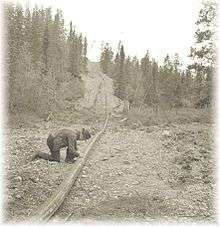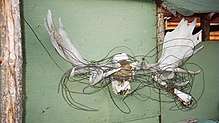Canol pipeline
The Canol pipeline was built to carry crude oil from Norman Wells, Northwest Territories, in Canada to Alaska, USA, during World War II.[1][2] The routing was to Johnsons Crossing and then along the Alaska highway to Whitehorse, Yukon, where a refinery was built.


Even though the pipeline was on Canadian territory, as a wartime expediency the building of the pipeline was overseen by the United States Army. Local workers were employed as well as civilians recruited in the South. Recruiting ads warned candidates not to apply unless they were prepared for the "harshest possible conditions".[3]
Construction began in 1942, and was completed in April 1944.[1][2] The pipeline was just 4 inches (10 cm) in diameter. The light crude oil from Norman Wells could be run through a narrow pipeline without being heated, where heavier crude requires heating.
The pipeline's main line was in use for less than fourteen months (19 December 1943 to 4 January 1945). The Canol pipeline actually consisted of four sections. Although the Norman Wells section was shut down, oil was received from Skagway and pumped to Fairbanks and a pipeline was also extended from Whitehorse to Watson Lake. The pipeline's route is now a wilderness hiking trail—the Canol Heritage Trail.
CBC News reported that 20 percent of the oil shipped through the pipeline is unaccounted for.[4] The Norman Wells Museum contains skulls of Moose and Caribou that died when their antlers were caught in wires that ran parallel to the pipeline. They reported that, when the war ended, American forces had simply abandoned all their infrastructure, making no effort to repair the environmental damage the pipeline had caused.
See also
References
- R.B. MacNaughton; E. Macey; J.M. Monro Gray; A.D. McCracken; G.S. Nowlan (December 2009). "The Canol Trail Background" (PDF). Norman Wells Museum. Archived from the original (PDF) on 2013-10-13. Retrieved 2014-08-18.
CANOL, short for Canadian Oil, was a project funded by the American military to build a pipeline from Norman Wells, Northwest Territories to Whitehorse, Yukon during World War II as the result of a possible Japanese attack on Alaska in 1942.
-
"Chapter 5: Canol Project". Alaska Highway Archives. Retrieved 2014-08-18.
At the height of the frenzied wartime construction of the Alaska Highway, yet another project was begun in northwestern Canada. Canol, short for Canadian American Norman Oil Line, was a pipeline system intended to provide fuel for the Alaska Highway and the Northwest Staging Route.
- "Canol pipeline" (PDF). Canada Geologic Survey. Archived from the original (PDF) on 2011-07-12. Retrieved 2014-08-19.
-
"WWII-era telephone lines snag N.W.T. moose, caribou: Abandoned 1940s Canol pipeline cleanup still a work in progress". CBC News. 2014-07-08. Archived from the original on 2014-08-16. Retrieved 2014-08-19.
The MLA for the Northwest Territories' Sahtu region was disturbed by several unexpected sites along the route: moose and caribou antlers, tangled up in old telephone wires that in some cases hang only inches off the ground.
External links
